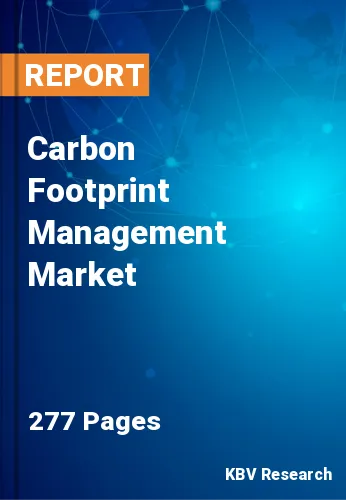The Global Carbon Footprint Management Market size is expected to reach $33.7 billion by 2029, rising at a market growth of 21.0% CAGR during the forecast period.
Energy & Utilities is one of the major applications of carbon footprint management because of the demand for heating and cooling, as well as the robust economy in the sector. In addition, adopting carbon footprint management results from the rise in carbon footprints caused by increased energy consumption and power generation. Hence, Energy & Utilities would generate approximately 1/5th share of the market by 2029. Adopting policies aimed at lowering greenhouse gases makes it easier for organizations to report on the results and behaviors of their members. The enactment of the United Nations Climate Change Conference, also known as COP26, is anticipated to propel numerous industries' adoption of carbon footprint management.
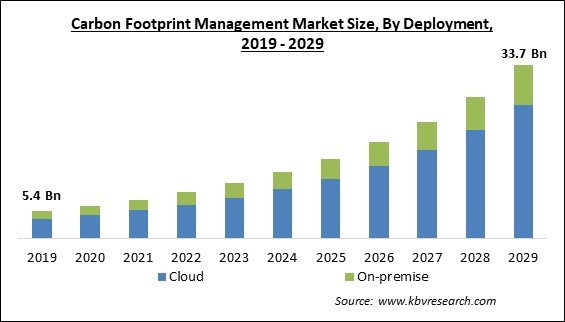
The major strategies followed by the market participants are Partnerships as the key developmental strategy to keep pace with the changing demands of end users. For instance, In November, 2021, Schneider partnered with GreenYellow for providing the global customers of both companies with energy efficiency programs. The partnership enhances the energy efficiency abilities of Schneider, thereby increasing its consulting capabilities. In addition, in February, 2023, Salesforce came into partnership with ERM, a global sustainability consultancy company. Through this partnership, both companies would help enterprises boost their decarbonization journeys and provide their sustainability goals.
Based on the Analysis presented in the Cardinal matrix; Schneider Electric SE are the forerunners in the Market. In April, 2022, AVEVA, a subsidiary of Schneider has partnered with FLSmidth for providing digital services and solutions to the mining industry. Additionally, both companies would boost the transformation to highly sustainable operations by combining world-leading processes and energy technologies for better asset performance at each level. Companies such as SAP SE, Salesforce, Inc. and IBM Corporation are some of the key innovators in the Market.
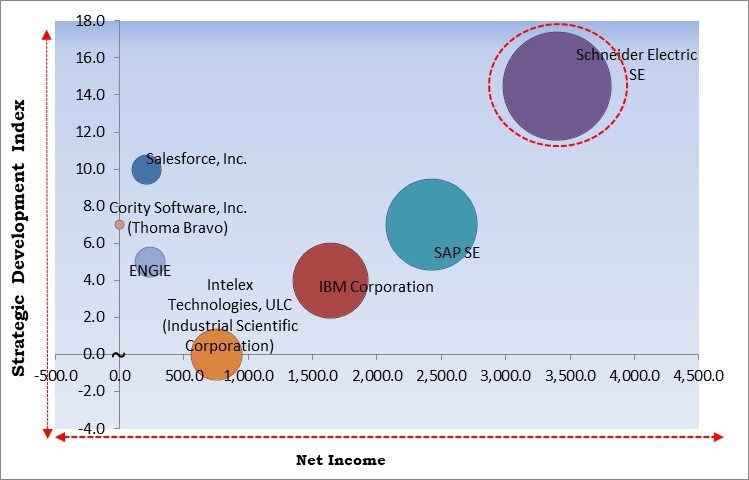
Government programs support using carbon footprint management tools to track, monitor, and reduce emissions produced by residences and enterprises. Numerous governments and stakeholders concerned about climate change are constantly developing policies and making changes to lower GHG and emission levels in the environment. According to the United Nations Environment Programme (UNEP), over 120 nations have set new NDC goals for reducing emissions by 2030. Governments responsible for around 70% of the world's CO2 emissions have vowed to achieve net-zero emissions by 2050. Hence, the government's growing efforts to reduce emissions propel the market's growth.
The world's economies are implementing paperless economies and cloud computing on a huge scale. For businesses adopting these strategies and environmentally friendly platforms to stop the emission of GHG and other carbon gases, nations provide a variety of subsidies. Using equipment as well as filtration caps in industrial settings like factories may be necessary for their adoption to reduce carbon emissions. The carbon footprint management application is used to ascertain the emission levels as well as document data through cloud or on-premise deployment before using these solutions, driving overall sales of the software. As a result, the market will soon be boosted by the inclusion and use of cloud computing for turning paperless.
The business has created green technologies to reduce the environmental impact of cars using cutting-edge techniques and carbon offsets to fight climate change. However, the adoption of low-carbon emission infrastructure by small firms is hampered by the challenge. The demand is also slowed down by a lack of knowledge about the advantages of funding low-carbon infrastructure. The high costs involved with upgrading to more modern infrastructure that is less harmful to the environment and produces fewer greenhouse gases limit market expansion.
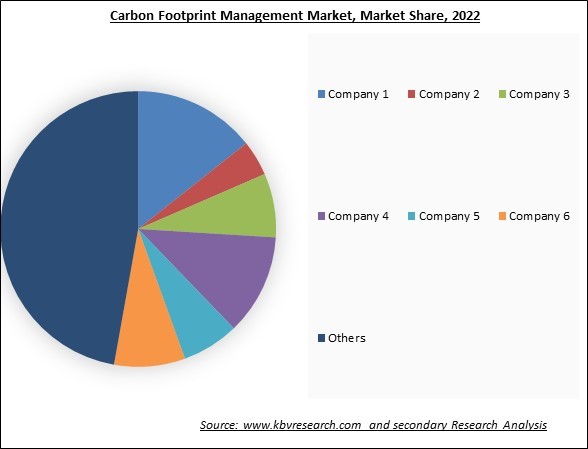
The leading players in the market are competing with diverse innovative offerings to remain competitive in the market. The above illustration shows the percentage of revenue shared by some of the leading companies in the market. The leading players of the market are adopting various strategies in order to cater demand coming from the different industries. The key developmental strategies in the market are Acquisitions, and Partnerships & Collaborations.
Based on component, the market is characterized into solution and services. The solution segment garnered the highest revenue share in the market in 2022. Easy installation, improved responsiveness, and precise data tracking for large and small businesses are the driving forces behind this segment's rapid expansion. An engaged supply chain is another element boosting the adoption of carbon footprint management technology. Consumers are becoming increasingly environmentally conscious and are more likely to support businesses that demonstrate their commitment to sustainability.
On the basis of deployment, the market is classified into cloud and on-premise. The cloud segment witnessed the maximum revenue share in the market in 2022. It is less expensive, more scalable, and easier to execute, maintain, and upgrade a carbon footprint management program over the cloud. Additionally, it provides advantages like security, data control, speed, and round-the-clock support, making it the top option for clients. Cloud deployment allows for easy customization and configuration of the application, enabling organizations to tailor the application to their specific needs and requirements.
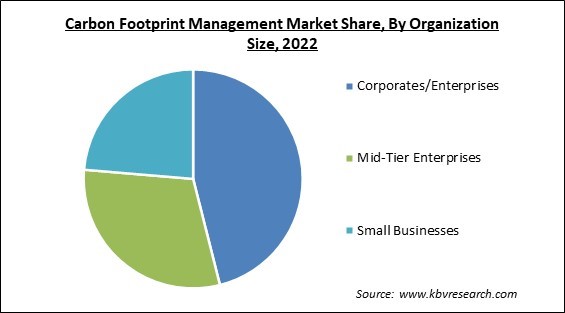
By organization size, the market is divided into corporate/enterprises, mid-tier enterprises, and small businesses. The small businesses segment acquired a substantial revenue share in the market in 2022. Due to the lesser size of their emissions, small enterprises have typically not faced governmental or stakeholder demand for emission/ESG reports. But throughout the projection period, this segment is predicted to rise quickly due to impending binding legislation in several industrialized economies worldwide and mounting investor pressure on emissions disclosure.
Based on application, the market is segmented into manufacturing, energy & utilities, residential & commercial buildings, transportation & logistics, IT & telecom, financial services, government, and others. The manufacturing segment recorded the largest revenue share in the market in 2022. One of the leading worldwide producers of carbon emissions is the manufacturing sector. Some manufacturers have come to terms with the realities of carbon emissions, while many others continue searching for ways to cut them during manufacturing.
| Report Attribute | Details |
|---|---|
| Market size value in 2022 | USD 9 Billion |
| Market size forecast in 2029 | USD 33.7 Billion |
| Base Year | 2022 |
| Historical Period | 2019 to 2021 |
| Forecast Period | 2023 to 2029 |
| Revenue Growth Rate | CAGR of 21% from 2023 to 2029 |
| Number of Pages | 277 |
| Number of Table | 464 |
| Report coverage | Market Trends, Revenue Estimation and Forecast, Segmentation Analysis, Regional and Country Breakdown, Market Share Analysis, Competitive Landscape, Companies Strategic Developments, Company Profiling |
| Segments covered | Component, Organization Size, Deployment, Vertical, Region |
| Country scope | US, Canada, Mexico, Germany, UK, France, Russia, Spain, Italy, China, Japan, India, South Korea, Singapore, Malaysia, Brazil, Argentina, UAE, Saudi Arabia, South Africa, Nigeria |
| Growth Drivers |
|
| Restraints |
|
Region wise, the market is analyzed across North America, Europe, Asia Pacific, and LAMEA. The North America segment garnered the highest revenue share in the market in 2022. Due to the region's aggressive efforts to mitigate the consequences of climate change, North America has a growing market. As a result, the nations in the region have established strict nationally determined contribution (NDC) goals and enforceable environmental, social, and governance (ESG) laws. As a result, over the coming years, demand is anticipated to increase significantly.
Free Valuable Insights: Global Carbon Footprint Management Market size to reach USD 33.7 Billion by 2029
The market research report covers the analysis of key stake holders of the market. Key companies profiled in the report include Schneider Electric SE, SAP SE, Salesforce, Inc., IBM Corporation, ENGIE, Intelex Technologies, ULC, IsoMetrix, Cority Software, Inc. (Thoma Bravo), Dakota Software Corporation and Locus Technologies.
By Deployment
By Organization Size
By Component
By Vertical
By Geography
This Market size is expected to reach $33.7 billion by 2029.
Growing governmental efforts to implement low-carbon policies are driving the Market in coming years, however, High initial expenditure restraints the growth of the Market.
Schneider Electric SE, SAP SE, Salesforce, Inc., IBM Corporation, ENGIE, Intelex Technologies, ULC, IsoMetrix, Cority Software, Inc. (Thoma Bravo), Dakota Software Corporation and Locus Technologies.
The Corporates/Enterprises segment is leading the Market by Organization Size in 2022 thereby, achieving a market value of $14.6 billion by 2029.
The North America market dominated the Market by Region in 2022 and would continue to be a dominant market till 2029; thereby, achieving a market value of $12.1 billion by 2029.
Our team of dedicated experts can provide you with attractive expansion opportunities for your business.
